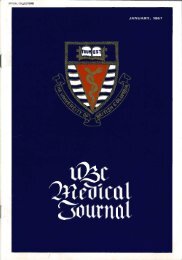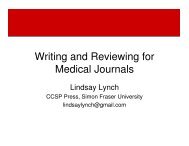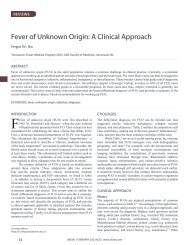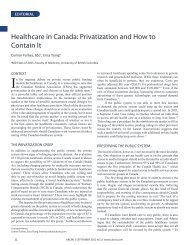Download article - UBC Medical Journal
Download article - UBC Medical Journal
Download article - UBC Medical Journal
You also want an ePaper? Increase the reach of your titles
YUMPU automatically turns print PDFs into web optimized ePapers that Google loves.
REVIEW<br />
of evidence be applied at all levels of EBM. The term “evidencebased”<br />
may be used incorrectly or out of context, and it is important<br />
to consider factors such as for-profit funding, inappropriate<br />
controls, use of surrogate outcomes, publication and reporting<br />
biases and misleading reporting, when assessing the validity<br />
of individual studies or reviews. 14 This is the rationale behind<br />
the need to teach principles of EBM in addition to applying it<br />
in practice. Although systematic reviews are deemed to be the<br />
strongest form of medical evidence, not all systemic reviews<br />
follow the same set of standardized methodology or are of equal<br />
quality and reliability. A poorly conducted systematic review<br />
may not be immediately obvious to the reader. Additionally,<br />
many systematic reviews are not current; only Cochrane reviews<br />
are reliably updated every two years. Thus, simply reading the<br />
conclusion of a systematic review is seldom sufficient.<br />
Challenges Facing EBM<br />
While EBM may seem to be the calling of medicine in the twentyfirst<br />
century, there are many barriers that EBM faces before it can<br />
become completely accepted as the standard in patient care. While<br />
some arguments against EBM are based on misunderstandings,<br />
other concerns are legitimate and must be addressed. A common<br />
criticism is that EBM is a clinical cookbook for physicians to apply<br />
to every patient with a certain illness. However, it is important to<br />
understand that EBM is only one component of clinical practice:<br />
the goal of EBM is to allow the physician to integrate patient<br />
preferences with clinical judgment and appropriate evidence. 14<br />
Another misconception is that only the results of RCTs should be<br />
used as a basis for clinical recommendations. While RCTs may<br />
be desirable, they are not, as discussed earlier, suitable for all<br />
situations and outcomes. 14 EBM strives to use the best available<br />
evidence, which may not always be the best form of evidence (i.e.,<br />
when RCTs are not available). Finally, a lack of evidence in the<br />
literature is not equivalent proof that a certain intervention lacks<br />
effectiveness. 14 EBM serves to identify knowledge gaps in the<br />
literature, acting as an important stimulus for additional RCTs.<br />
There exist other genuine concerns that need to be addressed<br />
before EBM becomes more widely accepted. The greatest<br />
challenge now is identifying ways to modify clinical behaviour<br />
so that EBM is used routinely by practicing physicians. 15 As<br />
in any professional field, there is often resistance to change.<br />
Barriers to the adoption of EBM often cited by physicians include<br />
feasibility, time constraints, and inadequate resources. 15 In a<br />
study of surgical residents, challenges faced in the application of<br />
EBM were categorized as 1) at the institutional level, where the<br />
availability of resources and time needed to obtain them is limited;<br />
2) at the resident level, where the motivation and desire to apply<br />
literature to practice is lacking and resistance from attending staff<br />
is sensed; and 3) at the attending level, where there is inadequate<br />
EBM knowledge and practice. All three factors impeded the use<br />
of EBM. 15<br />
Finally, the private sector constitutes another substantial<br />
barrier to the proper implementation of EBM. Several of these<br />
issues have been raised previously, including for-profit funding<br />
of research trials and the marketing of medications based on<br />
surrogate outcomes. Pharmaceutical companies may oppose<br />
EBM when it conflicts with their marketing strategies and when<br />
certain medications, which may be more costly than oldergeneration<br />
drugs, are not shown to be any better in terms of<br />
clinical outcomes. It is also imperative to consider the influence<br />
that the pharmaceutical industry has on the development of<br />
clinical guidelines. Unfortunately, many current guidelines do not<br />
follow EBM principles as they are funded by groups with a vested<br />
interest. It is therefore vital that clinicians view recommended<br />
guidelines critically and be aware of biases when applying them<br />
in practice.<br />
Summary<br />
Although EBM continues to evolve and play a key role in providing<br />
systematic reviews to answer crucial questions in medical<br />
practice, there remain numerous challenges in the dissemination,<br />
acceptance, and application of that evidence. The principles of<br />
EBM are rooted in the use of the best-possible study designs,<br />
large sample sizes, and the careful and unbiased interpretation of<br />
the best available evidence to support or oppose given medical<br />
treatments or interventions. However, although EBM may help<br />
provide a fundamental framework for practitioners in the delivery<br />
of health care, it must be applied appropriately and be sensitive to<br />
the needs of individual patients.<br />
References<br />
1. Sackett DL, Rosenberg WM, Gray JA, Haynes RB, Richardson WS.<br />
Evidence-based medicine: what it is and what it isn’t. BMJ 1996<br />
312:71-72.<br />
2. Antes G, Galandi D, Bouillon B. What is evidence-based medicine<br />
Langenbeck’s Arch Surg 1999 384:409–416.<br />
3. Ghosh AK. Clinical applications and update on evidence-based<br />
medicine. JAPI 2007 55:787-794.<br />
4. <strong>Medical</strong> Milestones [Online]. 2007 Jan 6 [Cited 2009 Mar 23];[2<br />
screens]. Available from: URL: http://www.bmj.com/cgi/content/<br />
full/334/suppl_1/DC3 .<br />
5. Sackett DL, Rosenberg WMC. The need for evidence-based medicine.<br />
J R Soc Med 88: 620-624.<br />
6. Tosi F, Muggeo M, Brun E, Spiazzi G, Perobelli L, Zanolin E, et al.<br />
Combination treatment with metformin and glibenclamide versus<br />
single-drug therapies in type 2 diabetes mellitus: a randomized,<br />
double-blind, comparative study. Metabolism 2003 52: 862-7.<br />
7. Baron JA, Sandler RS, Bresalier RS, Lanas A, Morton DG, Riddell R,<br />
et al. Cardiovascular events associated with rofecoxib: final analysis<br />
of the APPROVe trial. Lancet 2008 372: 1756-64.<br />
8. The Cochrane Collaboration. About the Cochrane collaboration<br />
[online]. [Cited 2009 Mar 23]; Available from: URL: http://www.<br />
cochrane.org/docs/descrip.htm.<br />
9. Therapeutics Initiative. Overview [online]. [Cited 2009 Mar 23]:<br />
Available from: URL: http://www.ti.ubc.ca/AboutUs.<br />
10. Therapeutics Initiative. Mild hypertension, an approach to using<br />
evidence in the decision making process. TI [serial online] 2007 Jan-<br />
Feb [cited 2009 Mar 23rd], letter 62: [2 screens]. Available from:<br />
URL: http://www.ti.ubc.ca/PDF/62.pdf.<br />
11. Taheri H, Mirmohamadsadeghi M, Adibi I, Ashorion V, Sadeghizade<br />
A, Adibi P. Evidence-based Medicine (EBM) for Undergraduate<br />
<strong>Medical</strong> Students. Ann Acad Med Singapore 2008 37:764-8.<br />
12. West CP. McDonald FS. Evaluation of a longitudinal medical school<br />
evidence-based medicine curriculum: a pilot study. J Intern Med 2008<br />
23:1057-9.<br />
13. Lui JC, Stewart MG. Teaching Evidence-Based Medicine in<br />
Otolaryngology. Otolaryngol Clin N Am 2007 40:1261-1274.<br />
14. Montori VM, Guyatt GH. Progress in Evidence-Based Medicine.<br />
JAMA 2008 300:1814-1816.<br />
15. Barratt A. Evidence Based Medicine and Shared Decision Making:<br />
The challenge of getting both evidence and preferences into health<br />
care. Patient Educ Couns 2008 73:407-412.<br />
18<br />
<strong>UBC</strong>MJ | SEPTEMBER 2009 1(1) | www.ubcmj.com










